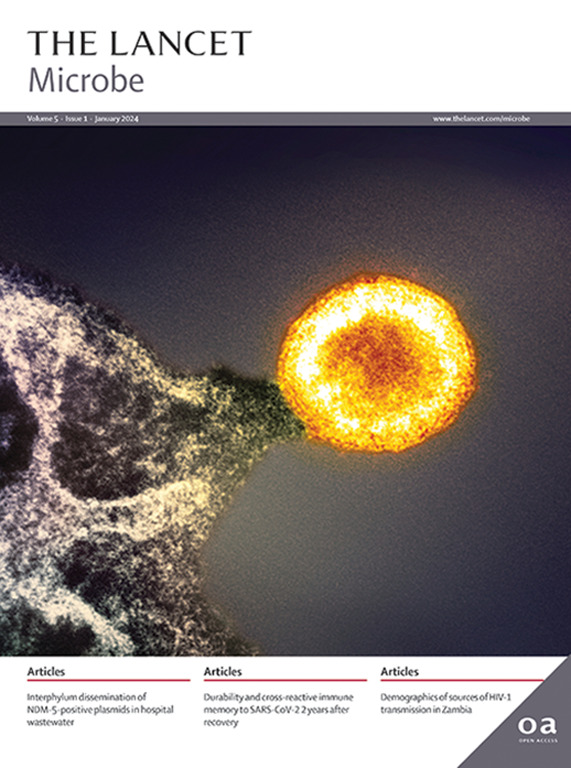英国持续感染个体的SARS-CoV-2基因组多样性和宿主内进化:一项观察性、纵向、基于人群的监测研究
IF 20.4
1区 生物学
Q1 INFECTIOUS DISEASES
引用次数: 0
摘要
背景:已知住院的免疫功能低下个体持续感染SARS-CoV-2可促进宿主内病毒的加速进化,可能导致高度分化变体的出现。然而,对于在普通人群中持续感染的进化动力学和传播风险知之甚少。我们的目的是描述通过大型社区监测研究确定的持续感染期间SARS-CoV-2在宿主内的进化特征。方法:我们使用了国家统计局COVID-19感染调查(ONS-CIS)的数据,这是一项于2020年4月至2023年3月在英国进行的大规模、纵向、基于人群的监测研究。在这项分析中,我们重点研究了来自七个主要SARS-CoV-2谱系(alpha、delta、BA.1、BA.2、BA.4、BA.5和XBB)的高病毒载量(周期阈值≤30)和可用基因组序列的感染。ONS-CIS参与者从一般人群中随机选择,无论症状如何,均定期进行RT-PCR检测。我们将持续性感染定义为持续或反弹的高病毒RNA滴度持续26天或更长时间。我们检查了相关的宿主特征,并使用原始序列数据来识别新生突变,并估计宿主内整个SARS-CoV-2基因组的同义和非同义进化率。研究结果:在2020年11月2日至2023年3月21日期间,我们发现了576例至少有两种序列的持续感染,包括11例alpha, 106例delta, 102例BA.1, 204例BA.2, 16例BA.4, 133例BA.5和4例XBB。持续感染在男性中比女性更常见(每年每个位点p-4替换(IQR 7·0-9·0 × 10-4),个体间变异很大程度上是由非同义突变驱动的,特别是在刺突蛋白的n端和受体结合域。较长的感染持续时间与较高的进化率相关,而与年龄、性别、疫苗接种状况、既往感染或病毒谱系没有关联。在84例持续56天或更长时间的持续感染中,我们没有发现任何超过感染第一个月的明显传播证据。总共鉴定出379个复发突变,其中包括许多已知或预测的负适合度效应和种群水平低流行率,以及可能在这些个体内的正选择下重新恢复到武汉-胡-1参考序列的突变。解释:本研究强调了社区中持续感染个体的宿主内SARS-CoV-2进化的异质性。值得注意的是,一小部分具有高病毒载量的持续感染经历了加速的病毒进化或在新变体中反复获得标志性突变。此外,在感染的后期阶段由持续感染继续传播的情况可能很少见。这些见解对优先进行基因组监测和管理持续感染患者具有重要意义。资助:卫生和社会保障部。本文章由计算机程序翻译,如有差异,请以英文原文为准。
SARS-CoV-2 genomic diversity and within-host evolution in individuals with persistent infection in the UK: an observational, longitudinal, population-based surveillance study
Background
Persistent SARS-CoV-2 infections in hospitalised immunocompromised individuals are known to facilitate accelerated within-host viral evolution, potentially contributing to the emergence of highly divergent variants. However, little is known about the evolutionary dynamics and transmission risks of persistent infections in the general population. We aimed to characterise the within-host evolution of SARS-CoV-2 during persistent infections identified through a large community surveillance study.
Methods
We used data from the Office for National Statistics COVID-19 Infection Survey (ONS-CIS), a large-scale, longitudinal, population-based surveillance study conducted in the UK from April, 2020, to March, 2023. For this analysis, we focused on infections with high viral load (cycle threshold ≤30) and available genome sequences, from seven major SARS-CoV-2 lineages (alpha, delta, BA.1, BA.2, BA.4, BA.5, and XBB). ONS-CIS participants were randomly selected from the general population and tested regularly by RT-PCR, regardless of symptoms. We defined persistent infections as those with sustained or rebounding high viral RNA titres for 26 days or longer. We examined associated host characteristics and used raw sequence data to identify de novo mutations and estimate within-host synonymous and non-synonymous evolutionary rates across the SARS-CoV-2 genome.
Findings
Between Nov 2, 2020, and March 21, 2023, we identified 576 persistent infections with at least two sequences, including 11 alpha, 106 delta, 102 BA.1, 204 BA.2, 16 BA.4, 133 BA.5, and 4 XBB. Persistent infections were more common in males than females (p<0·0001) and individuals older than 60 years (p=0·0027). The median within-host genome-wide evolutionary rate was 7·9 × 10−4 substitutions per site per year (IQR 7·0–9·0 × 10–4), with high inter-individual variability driven largely by non-synonymous mutations, particularly in the N-terminal and receptor-binding domains of the spike protein. Longer infection duration was associated with higher evolutionary rates, while no associations were found with age, sex, vaccination status, previous infection, or virus lineage. We found no clear evidence of transmission beyond the first month of infection in any of the 84 persistent infections lasting 56 days or longer. In total, we identified 379 recurrent mutations, including many with known or predicted negative fitness effects and low prevalence at the population level, as well as de novo reversions to the Wuhan-Hu-1 reference sequence, which were likely under positive selection within those individuals.
Interpretation
This study highlights the heterogeneous nature of within-host SARS-CoV-2 evolution in individuals with persistent infection in the community. Notably, a small subset of persistent infections with high viral loads underwent accelerated viral evolution or recurrently acquired hallmark mutations found in novel variants. In addition, onward transmission from a persistent infection during the later stages of infection is likely to be rare. These insights have important implications for prioritising genomic surveillance and managing patients with persistent infections.
Funding
Department of Health and Social Care.
求助全文
通过发布文献求助,成功后即可免费获取论文全文。
去求助
来源期刊

Lancet Microbe
Multiple-
CiteScore
27.20
自引率
0.80%
发文量
278
审稿时长
6 weeks
期刊介绍:
The Lancet Microbe is a gold open access journal committed to publishing content relevant to clinical microbiologists worldwide, with a focus on studies that advance clinical understanding, challenge the status quo, and advocate change in health policy.
 求助内容:
求助内容: 应助结果提醒方式:
应助结果提醒方式:


